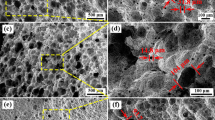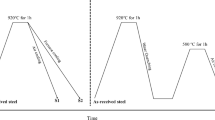Abstract
The effect of nanosized NbC precipitates on the stress corrosion cracking (SCC) of high-strength low-alloy (HSLA) steel in a simulated deep-sea environment was studied through electrochemical tests, hydrogen permeation tests and slow strain rate tension (SSRT) tests. The results show that in a simulated deep-sea environment, the presence of nanosized NbC precipitates significantly decreases electrochemical corrosion and SCC susceptibility. Nanosized NbC precipitates increased the amount of irreversible and reversible hydrogen traps, which pinned the hydrogen induced by the hydrogen evolution reaction, and weakened the effect of hydrogen on the AD and HE during SCC of HSLA steel. In addition, whether in deep- or shallow-sea environments, nanosized NbC precipitates improved the SCC resistance of HSLA steel by means of the hydrogen-trapping and microstructural optimization effect, but the microstructural optimization played a minor role. Once the steels were with higher hydrogen concentration, the hydrogen-trapping function of NbC precipitates increased, which resulted in larger SCC resistance improvement.











Similar content being viewed by others
References
S.W. Thompson, Interrelationships Between Yield Strength, Low-Temperature Impact Toughness, and Microstructure in Low-Carbon, Copper-Precipitation-Strengthened, High-Strength Low-Alloy Plate Steels, Mater. Sci. Eng. A, 2018, 711, p 424–433.
Z.J. Xie, X.P. Ma, C.J. Shang, X.M. Wang, and S.V. Subramanian, Nano-Sized Precipitation and Properties of a Low Carbon Niobium Micro-Alloyed Bainitic Steel, Mater. Sci. Eng. A, 2015, 641, p 37–44.
J. Jia, X. Cheng, X. Yang, X. Li, and W. Li, A Study for Corrosion Behavior of a New-Type Weathering Steel Used in Harsh Marine Environment, Constr. Build. Mater., 2020, 259, p 119760.
X. Li, L. Shi, Y. Liu, K. Gan, and C. Liu, Achieving a Desirable Combination of Mechanical Properties in HSLA Steel Through Step Quenching, Mater. Sci. Eng. A, 2020, 772, p 138683.
Y. Shao, C. Liu, Z. Yan, H. Li, and Y. Liu, Formation Mechanism and Control Methods of Acicular Ferrite in HSLA Steels: A Review, J. Mater. Sci. Technol., 2018, 34(5), p 737–744.
H. Wan, C. Du, Z. Liu, D. Song, and X. Li, The Effect of Hydrogen on Stress Corrosion Behavior of X65 Steel Welded Joint in Simulated Deep Sea Environment, Ocean Eng., 2016, 114, p 216–223.
Y. Yang, C. Jiang, X.Q. Cheng, J.B. Zhao, B.J. Zhao, and X.G. Li, Effect of Sb on the Corrosion Behavior of Low-Alloy Steels in a Simulated Polluted Marine Atmosphere, J. Mater. Eng. Perform., 2020, 29, p 2648–2657.
B. Sun, X. Zuo, X. Cheng et al., The Role of Chromium Content in the Long-Term Atmospheric Corrosion Process, npj Mater. Degrad., 2020, 4(37), p 1–9.
L. Wang, J. Xin, L. Cheng, K. Zhao, B. Sun, J. Li, X. Wang, and Z. Cui, Influence of Inclusions on Initiation of Pitting Corrosion and Stress Corrosion Cracking of X70 Steel in Near-Neutral pH Environment, Corros. Sci., 2019, 147, p 108–127.
H. Tian, J. Xin, Y. Li, X. Wang, and Z. Cui, Combined Effect of Cathodic Potential and Sulfur Species on Calcareous Deposition, Hydrogen Permeation, and Hydrogen Embrittlement of a Low Carbon Bainite Steel in Artificial Seawater, Corros. Sci., 2019, 158, p 108089.
W. Wu, Z. Liu, X. Li, and C. Du, Electrochemical Characteristic and Stress Corrosion Behavior of API X70 High-Strength Pipeline Steel Under a Simulated Disbonded Coating in an Artificial Seawater Environment, J. Electroanal. Chem., 2019, 845, p 92–105.
Q. Zhao, J. Zhao, X. Cheng, Y. Huang, L. Lu, and X. Li, Galvanic Corrosion of the Anodized 7050 Aluminum Alloy Coupled with the Low Hydrogen Embrittlement Cd Ti Plated 300M Steel in an Industrial-Marine Atmospheric Environment, Surf. Coat. Technol., 2020, 382, p 125171.
J.P. Carrasco, D.D. Silva Diniz, J.M. Andrade Barbosa, A.A. Silva, and M. Antonio dos Santos, Numerical Simulation of the Hydrogen Trapping Effect on Crack Propagation in API 5CT P110 Steel Under Cathodic Overprotection, Int. J. Hydrogen Energy, 2019, 44(5), p 3230–3239.
H.Q. Yang, Q. Zhang, S.S. Tu, Y.M. Li, Y. Wang, and Y. Huang, A Study on Effects of Mechanical Stress and Cathodic Protection on Marine Coatings on Mild Steel in Artificial Seawater, J. Mater. Eng. Perform., 2016, 25, p 3863–3879.
A. Drach, I. Tsukrov, J. DeCew, J. Aufrecht, A. Grohbauer, and U. Hofmann, Field Studies of Corrosion Behaviour of Copper Alloys in Natural Seawater, Corros. Sci., 2013, 76, p 453–464.
R.E. Melchers, Effect of Immersion Depth on Marine Corrosion of Mild Steel, Corrosion, 2005, 61(9), p 895–906.
R. Venkatesan, M.A. Venkatasamy, T.A. Bhaskaran, E.S. Dwarakadasa, and M. Ravindran, Corrosion of Ferrous Alloys in Deep Sea Environments, Br. Corros. J., 2013, 37(4), p 257–266.
R. Liu, Y. Cui, L. Liu, B. Zhang, and F. Wang, A Primary Study of the Effect of Hydrostatic Pressure on Stress Corrosion Cracking of Ti-6Al-4V Alloy in 3.5% NaCl Solution, Corros. Sci., 2020, 165, p 108402.
F. Sun, S. Ren, Z. Li, Z. Liu, X. Li, and C. Du, Comparative Study on the Stress Corrosion Cracking of X70 Pipeline Steel in Simulated Shallow and Deep Sea Environments, Mater. Sci. Eng. A, 2017, 685, p 145–153.
Z.X. Yang, B. Kan, J.X. Li, Y.J. Su, and L.J. Qiao, Hydrostatic Pressure Effects on Stress Corrosion Cracking of X70 Pipeline Steel in a Simulated Deep-Sea Environment, Int. J. Hydrogen Energy, 2017, 42(44), p 27446–27457.
P. Gong, E.J. Palmiere, and W.M. Rainforth, Dissolution and Precipitation Behaviour in Steels Microalloyed with Niobium During Thermomechanical Processing, Acta Mater., 2015, 97, p 392–403.
X.L. Cai, L.S. Zhong, and Y.H. Xu, Mechanical Properties and Tribological Behavior of In Situ NbC/Fe Surface Composites, J. Mater. Eng. Perform., 2017, 26, p 292–299.
X. Chen, G. Qiao, X. Han, X. Wang, F. Xiao, and B. Liao, Effects of Mo, Cr and Nb on Microstructure and Mechanical Properties of Heat Affected Zone for Nb-Bearing X80 Pipeline Steels, Mater. Des., 2014, 53, p 888–901.
S. Jeng, H. Lee, J. Huang, and R. Kuo, Effects of Nb on the Microstructure and Elevated-Temperature Mechanical Properties of Alloy 690-SUS 304L Dissimilar Welds, Mater. Trans., 2008, 49(6), p 1270–1277.
V. Javaheri, F. Shahri, M. Mohammadnezhad, M. Tamizifar, and M. Naseri, The Effect of Nb and Ti on Structure and Mechanical Properties of 12Ni-25Cr-0.4C Austenitic Heat-Resistant Steel After Aging at 900 °C for 1000 h, J. Mater. Eng. Perform., 2014, 23, p 3558–3566.
Y.S. Chen, H.Z. Lu, J.T. Liang et al., Observation of Hydrogen Trapping at Dislocations, Grain Boundaries, and Precipitates, Science, 2020, 367, p 171–175.
S. Zhang, J. Wan, Q. Zhao, J. Liu, F. Huang, Y. Huang, and X. Li, Dual Role of Nanosized NbC Precipitates in Hydrogen Embrittlement Susceptibility of Lath Martensitic Steel, Corros. Sci., 2020, 164, p 108345.
S. Zhang, E. Fan, J. Wan, J. Liu, Y. Huang, and X. Li, Effect of Nb on the Hydrogen-Induced Cracking of High-Strength Low-Alloy Steel, Corros. Sci., 2018, 139, p 83–96.
S. Zhang, Q. Zhao, J. Liu, F. Huang, Y. Huang, and X. Li, Understanding the Effect of Niobium on Hydrogen-Induced Blistering in Pipeline Steel: A Combined Experimental and Theoretical Study, Corros. Sci., 2019, 159, p 108142.
W. Wu, Z. Liu, Q. Wang, and X. Li, Improving the Resistance of High-Strength Steel to SCC in a SO2-Polluted Marine Atmosphere Through Nb and Sb Microalloying, Corros. Sci., 2020, 170, p 108693.
Q. Qiao, L. Lu, E. Fan, J. Zhao, Y. Liu, G. Peng, Y. Huang, and X. Li, Effects of Nb on Stress Corrosion Cracking of High-Strength Low-Alloy Steel in Simulated Seawater, Int. J. Hydrogen Energy, 2019, 44(51), p 27962–27973.
I. Flis-Kabulska, T. Zakroczymski, and J. Flis, Accelerated Entry of Hydrogen Into Iron from NaOH Solutions at Low Cathodic and low anodic polarisations, Electrochim. Acta, 2007, 52(9), p 2966–2977.
Q. Cui, J. Wu, D. Xie, X. Wu, Y. Huang, and X. Li, Effect of Nanosized NbC Precipitates on Hydrogen Diffusion in X80 Pipeline Steel, Materials, 2017, 10(7), p 721.
S.K. Yen and I.B. Huang, Critical Hydrogen Concentration for Hydrogen-Induced Blistering on AISI 430 Stainless Steel, Mater. Chem. Phys., 2003, 80(3), p 662–666.
C.F. Dong, Z.Y. Liu, X.G. Li, and Y.F. Cheng, Effects of Hydrogen-Charging on the Susceptibility of X100 Pipeline Steel to Hydrogen-Induced Cracking, Int. J. Hydrogen Energy, 2009, 34(24), p 9879–9884.
D.C. Cook, Spectroscopic Identification of Protective and Non-protective Corrosion Coatings on Steel Structures in Marine Environments, Corros. Sci., 2005, 47(10), p 2550–2570.
A.G. Kostryzhev, P. Mannan, and O.O. Marenych, High Temperature Dislocation Structure and NbC Precipitation in Three Ni-Fe-Nb-C Model Alloys, J. Mater. Sci., 2015, 50(21), p 7115–7125.
S. Lu, S. Wei, D. Li, and Y. Li, Effects of Heat Treatment Process and Niobium Addition on the Microstructure and Mechanical Properties of low Carbon Steel Weld Metal, J. Mater. Sci., 2010, 45(9), p 2390–2402.
M.L. Doche, J.Y. Hihn, A. Mandroyan, R. Viennet, and F. Touyeras, Influence of Ultrasound Power and Frequency Upon Corrosion Kinetics of Zinc in Saline Media, Ultrason. Sonochem., 2003, 10(6), p 357–362.
J. Tang, Y. Shao, T. Zhang, G. Meng, and F. Wang, Corrosion Behaviour of Carbon Steel in Different Concentrations of HCl Solutions Containing H2S at 90°C, Corros. Sci., 2011, 53(5), p 1715–1723.
G.Z. Meng, C. Zhang, and Y.F. Cheng, Effects of Corrosion Product Deposit on the Subsequent Cathodic and Anodic Reactions of X-70 Steel in Near-Neutral pH Solution, Corros. Sci., 2008, 50(11), p 3116–3122.
J. Li, J. Wu, Z. Wang, S. Zhang, X. Wu, Y. Huang, and X. Li, The Effect of Nanosized NbC Precipitates on Electrochemical Corrosion Behavior of High-Strength Low-Alloy Steel in 3.5%NaCl Solution, Int. J. Hydrogen Energy, 2017, 42(34), p 22175–22184.
X.L. Xiong, H.X. Ma, X. Tao, J.X. Li, Y.J. Su, Q.J. Zhou, and A.A. Volinsky, Hydrostatic Pressure Effects on the Kinetic Parameters of Hydrogen Evolution and Permeation in Armco Iron, Electrochim. Acta, 2017, 255, p p230-238.
X.L. Xiong, X. Tao, Q.J. Zhou, J.X. Li, A.A. Volinsky, and Y.J. Su, Hydrostatic Pressure Effects on Hydrogen Permeation in A514 Steel During Galvanostatic Hydrogen Charging, Corros. Sci., 2016, 112, p 86–93.
E.D. Fan, S.Q. Zhang, D.H. Xie et al., Effect of Nanosized NbC Precipitates on Hydrogen Induced Cracking, Int. J. Miner. Metall. Mater., 2020 https://doi.org/10.1007/s12613-020-2167-0
G.M. Pressouyre, A Classification of Hydrogen Traps in Steel, Metall. Trans. A, 1979, 10(10), p 1571–1573.
P. Castaño Rivera, V.P. Ramunni, and P. Bruzzoni, Hydrogen Trapping in an API 5L X60 Steel, Corros. Sci., 2012, 54, p 106–118.
A. Turnbull and S. Zhou, Pit to Crack Transition in Stress Corrosion Cracking of a Steam Turbine Disc Steel, Corros. Sci., 2004, 46(5), p 1239–1264.
B. Gu, J. Luo, and X. Mao, Hydrogen-Facilitated Anodic Dissolution-Type Stress Corrosion Cracking of Pipeline Steels in Near-Neutral pH Solution, Corrosion, 1999, 55(1), p 96–106.
Acknowledgments
The authors wish to acknowledge the financial support of the National Key Research and Development Program of China (No. 2016YFB0300604), the National Natural Science Foundation of China (Nos. 51971033, 51471033) and the National Materials Corrosion and Protection Data Center.
Author information
Authors and Affiliations
Corresponding authors
Additional information
Publisher's Note
Springer Nature remains neutral with regard to jurisdictional claims in published maps and institutional affiliations.
Rights and permissions
About this article
Cite this article
Zhao, Q., Fan, E., Wang, S. et al. Understanding the Effect of Nanosized NbC Precipitates on the Stress Corrosion Cracking of High-Strength Low-Alloy Steel in a Simulated Deep-Sea Environment. J. of Materi Eng and Perform 30, 2159–2173 (2021). https://doi.org/10.1007/s11665-021-05532-7
Received:
Revised:
Accepted:
Published:
Issue Date:
DOI: https://doi.org/10.1007/s11665-021-05532-7




